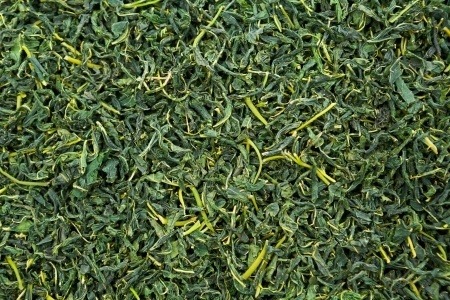
- Traditionally considered to be highly beneficial in health especially for digestion, heart and liver health
- Mulberry leaf tea has been drunk for millennia in China.
I came across Mulberry Leaf Tea supplied by Ranong Tea (Benefit Tea) at the IFE exhibition (Excel Centre, London) in 2011 and was struck by how pleasant the aroma and flavour was given I’d tasted a number of tea products throughout the day. The Japanese leaf tea has a flavour similar to other green teas but with a slightly more drying note to it. I’ve been drinking this variant on a regular basis. It is a 70:30 blend of mulberry tea and Japanese Green tea leaves. The technical information I was supplied with listed a variety of nutritional components with putative benefits, but I was interested to see if any research had been conducted on mulberry tea in particular.
The technical benefits sheet listed the following components :-
– Deoxynojirimycin
– GABA – Gamma aminobutyric acid which has a key role in citrate metabolism.
– Phytosterol – Ecdysteroids (20-hydroxyecdysone and inokosterone)
– Quercetin
– Flavonoid
– Vitamin A & B1 (thiamine), C
– Calcium & potassium
All these components have well understood benefits but it would help to know how much of each is present. Likewise, there are a number of different mulberry species and so it would be interesting to know if the reputed benefits cover all species and to what degree. Mulberry tea in this case probably comes from the species M. alba L.
Green teas generally have been the subject of much more clinical research than mulberry tea and have been reported in large population studies. One of the most interesting findings is the role that tea generally might play in weight management and a recent study in humans focussed on extracts of mulberry tea with black and green tea which slowed absorption following a high fat and/or high carbohydrate meal (Zhong et al., 2006). Mulberry leaf itself contains alkaloids of the 1-deoxynojirimycin type (Asano et al., 1994; Hansawasdi and Kawabata, 2006). These sort of compounds inhibit intestinal α-glucosidase which are involved in the breakdown of specific types of carbohydrate which implies reduced intestinal absorption of sugars. This may help explain some of the low uptake of carbohydrates researchers found and the benefits for those of us involved in dieting.
Mulberry Tea For Diabetes Management
Tea has also been used in the Far East as a way of helping in the management of diabetes. We know of a few published studies which demonstrate the benefits with this condition. The perceived benefit has been a reduction in blood glucose in type 2 diabetes –human and animal. One study has shown that extracts of mulberry reduce blood glucose in type 2 diabetic persons (Andallu et al., 2001) although it is a single study. There is a reported antioxidant activity (Wanyo et al., 2011) and even some melatonin in the fresh leaf, reportedly at the 100 ng/g dry weight level.
The ecdysteroids (20-hydroxyecdysone and inokosterone) are suspected of also having an anti-diabetic effect. Such compounds can enhance tissue sensitivity to insulin in rats when applied per os (Lafont and Dinan, 2003).
Much of the benefit it seems must be inferred from other teas which have very different characterisation. Hopefully, there will be many more human intervention studies to demonstrate significant benefits specifically for Mulberry tea.
References
Andallu, B., Suryakantham,V., Srikanthi, B.L., Reddy, K.S. (2001) Effect of mulberry (Morus Indica L.) therapy on plasma and erythrocyte membrane lipids and patients with type 2 diabetes. Clin. Chim. Acta. 314 pp. 47–53.
Asano N, Oseki, K., Tomioka, E., Kizu, H., Matsui, K. (1994) N-containing sugars from Morus alba and their glycosidase inhibitory activities. Carbohydr. Res. 259 pp. 243–55
Hansawasdi, C., and Kawabata, J. (2006) α-Glucosidase inhibitory effect of mulberry (Morus alba) leaves on Caco-2. Fitoterapia 77(7-8) pp. 568-573
Lafont, R., Dinan, L.(2003) Practical uses for ecdysteroids in mammals including humans: an update. J. Insect Sci. 3:7; online: http://insectscience.org/3.7.
Zhong, L., Furne, J.K., Levitt, M.D. (2006) An extract of black, green, and mulberry teas causes malabsorption of carbohydrate but not of triacylglycerol in healthy volunteers. Am J Clin Nutr. 84pp. 551–5
Thanks for visiting our stand at this years International Food Exhibition, London and we are enormously pleased that you enjoyed our tea’s.
In Thailand alone, over 2.5 million cups are consumed by Ranong customers each year, which makes us believe that as a health conscious people they are trying to tell us something.
Should any one wish to try our tea’s please contact us through our web site http://www.benefittea.co.uk and we shall arrange a few samples to be sent.
Thanks for the interest and time to write about our product.
Best Wishes
BenefitTea
Dear Sir,
Have you any plans to produce new variants of the tea and if you have any other formats available – RTD for example ?
Alastair
Hi Alastair,
This year has been the very first launch to introduce 100% Mulberry, Mulberry & Japanese Tea, Mulberry with Jasmine Flower Tea into the UK.
With our first launch and sales at Selfridges, Oxford Street, London. Celebrating “Tastes of Thailand” it is encouraging that Mulberry is perceived as a quality, new and exciting drink.
Several top restaurants are now interested in our tea’s including the renowned Club Gascon.
In Thailand Ranong offer a wide range of Tea’s to it’s customers including ginger, lemon and rice. Trials to these here in the UK show that there is mixed interest. Regards RTD drinks, again there is development within the Thai home market but with regards to the UK and Europe indicators show a negative in CAGR for RTD Tea’s. This may well be due to bad weather and down turn of economies.
As such we shall focus on the specialist hot tea market and our initial three great tea’s.